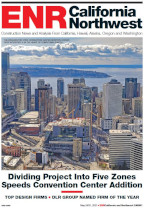The erection strategy involved site-assembly, on the ground, of each box by the joint venture of Dallas-based Bosworth Steel Erectors Inc. and the local Forest City Erectors Inc. Crews would then pick each box and set it on a tree before erecting the 60-ft-long trusses.
The floor-to-ceiling height is only 38 ft. MKA had to maintain a 30-ft clearance from the mat to the truss bottom chord. The trees minimized tonnage in the rather shallow truss system, says Beaman. "The diagonal branches cut the effective span from 90 feet to 60 feet."
During erection, each box maintained a high level of weight balance over the center of the tree, says Beaman. As a result, there was a nominal amount of temporary steel—a pipe shore under each branch—to stabilize the unit until ironworkers added the intermediate trusses.
Collaborative BIM helped avoid many clashes, especially in the exhibit hall, where ductwork and piping are threaded through ceiling trusses, says Turner. For example, as Schuff's detailer completed 3D shop drawings, Turner used them to replace the design BIM, enhancing the accuracy of the model.
Other high-tech tools aided the schedule. The project began just as iPads were coming onto the market. There are now about 80 tablets in the field, says Turner.
In addition to giving people in the field easy access to 2,000 contract documents, some 20,000 shop drawings and a variety of standard project forms, the tablets expedite resolutions to requests for information, especially where new and existing structures meet.
Often, when as-built conditions differ from documents, "we take a picture, mark it up, write down the dimensions and send it to the engineer," says Dewine. "We can receive a reply in 15 minutes."
In one instance, a low-tech resource came to the rescue. During the project, workers could not disturb the auditorium's gravity-acting dewatering system, which consisted of buried vitrified clay pipe around the building.
But Turner only had incomplete as-built drawings to guide workers. Turner's risk consultant, a former geotechnical engineer, turned up manuscript versions of two helpful articles on the auditorium that had been published in ENR—one in 1918 and the other in 1920.
"We avoided touching the system thanks to the ENR articles," says Dewine.






Post a comment to this article
Report Abusive Comment